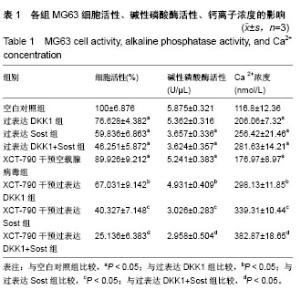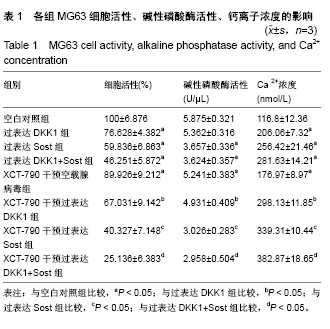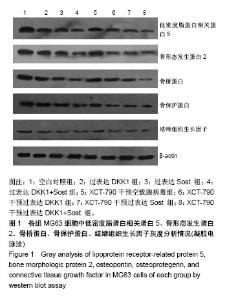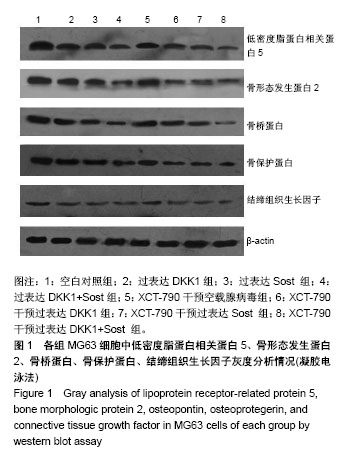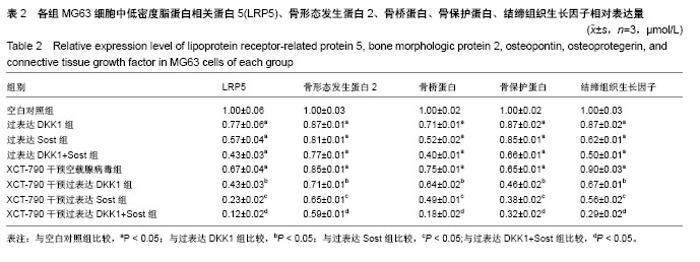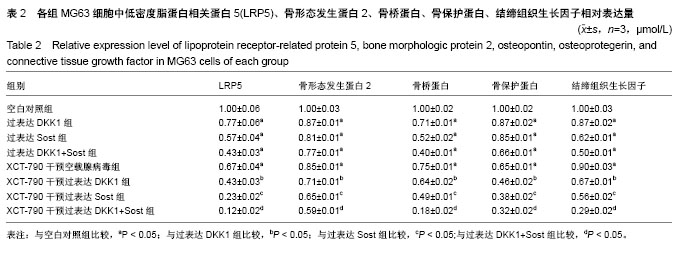| [1] 中华医学会骨质疏松和骨矿盐疾病分会,原发性骨质疏松症诊疗指南(2017)[J].中华骨质疏松和骨矿盐疾病杂志 2017,5(10): 413-444.[2] Carnesecchi J,Vanacker JM.Estrogen-Related Receptors and the control of bone cell fate. Mol Cell Endocrinol.2016;432: 37-43.[3] Lu X,Peng L,Lv M,et al.Recent advance in the design of small molecular modulators of estrogen-related receptors.Curr Pharm Des.2012;18(23): 3421-3431.[4] Chen Z, Xue J, Shen T,et al. Curcumin alleviates glucocorticoid-induced osteoporosis through the regulation of the Wnt signaling pathway. Int J Mol Med. 2016;37(2): 329-338.[5] Sankaralingam A, Roplekar R, Turner C, et al.Changes in Dickkopf-1 (DKK1) and Sclerostin following a Loading Dose of Vitamin D2(300,000 IU). J Osteoporos. 2014;2014: 682763.[6] 李钊政,万雷,乔荣勤,等. XCT-790对沉默Dkk1腺病毒载体转染MG63细胞中OPG、CTGF、FGF2、TNFα的影响研究[J].中国骨质疏松杂志,2017,7(23):841-845.[7] 肖本浩,万雷,张志海,等. XCT-790对沉默Dkk1腺病毒载体转染MG63细胞活性和OPN、Lrp5、BMP2影响研究[J]. 辽宁中医药大学学报2017,11(19):65-68.[8] 万雷,黄宏兴,黄红,等.过表达DKK1、Sost重组腺病毒载体的构建及其对MG63细胞和相关蛋白的影响[J]. 广州中医药大学学报, 2016,33(4): 578-584.[9] Meier C,Lamy O,Krieg MA,et al.The role of teriparatide in sequential and combination therapy of osteoporosis. Swiss Med Wkly. 2014;144:w13952. [10] 周立新,宋倩,薛鹏,等.雌激素对成骨细胞作用机制的研究进展[J].河北医科大学学报, 2014,23(5): 613-616.[11] Huss JM,Garbacz WG,Xie W.Constitutive activities of estrogen-related receptors: Transcriptional regulation of metabolism by the ERR pathways in health and disease. Biochim Biophys Acta. 2015;1852(9):1912-1927.[12] Kocem ba KA,Groen RW,van AndelH,et al.Transcriptional silencing ofthe Wnt-antagonist DKK1 by promoter methylation is associated with enhanced Wnt signaling in advanced multiple myeloma.PLoS One.2012;7(2):330. [13] Simpson CA,Foer D,Lee GS,et al.Serum levels of sclerostin, Dickkopf-1,and secreted frizzled-related protein-4 are not changed in individuals with high bone mass causing mutations in LRP5.Osteoporos Int.2014;25:2383-2388. [14] Chapurlat RD,Confavreux CB. Novel biological markers of bone:from bone metabolism to bone physiology. Rheumatology. 2016;55:1714-1725.[15] Auld KL, Berasi SP, Liu Y,et al.Estrogen-related receptor α regulates osteoblast differentiation via Wnt/β-catenin signaling. J Mol Endocrinol. 2012;48(2):177-191.[16] Bart O.Williams.LRP5:From bedside to bench to bone.Bone. 2017;102:26-30. [17] Yan XZ,Ge SH,Sun QF,et al.A pilot study evaluating the effect of recombinant human bone morphogenetic protein-2 and recombinant human beta-nerve growth factor on the healing of Class III furcation defects in dogs.J Periodontol.2010;81(9): 1289-1298.[18] Mandal CC,Ganapathy S,Gorin Y,et al.Reactive oxygen species derived from Nox4 mediate BMP2 gene transcription and osteoblast differentiation.Biochem J.2011;433(2): 393-402.[19] Al-Amer O. Bone marker gene expression in calvarial bones:diferent bone microenvironments. J Biol Res (Thessalon). 2017;24:9.[20] 王增田,王心,杨静,等.骨桥蛋白影响破骨细胞、成骨细胞参与骨重塑过程的研究进展[J].武警后勤学院学报(医学版), 2014, 23(12):1062. [21] Zirngibl RA,Chan JS,Aubin JE.Estrogenreceptor-related receptorα(ERRα) regulates osteopontion expression through a non-canonical ERRα response elementin a cell context dependent manner.JMol Endocrinol.2008;40:61-73.[22] Kawata K,Kubota S,Eguchi T,Et al.Role of lo-density lipoprotein receptor related protein 1(lrp1) in ccn2/con-nective tissue growth factor(ctgf) protein transport in hon-drocytes.Cell Sci.2012;125( 12):2965-2972.[23] 张丽,姜丽燕,张良岩,等. CTG对破骨前体细胞RAW264.7 增殖及碳酸酐酶Ⅱ分化的影响[J].中国骨质疏松杂志,2014,20(2): 133-136.[24] 万雷,黄宏兴,黄红,等.沉默DKK1、Sost重组腺病毒载体的构建及其对MG63细胞增殖、ALP活性和钙离子浓度影响研究[J].中国骨质疏松杂志,2016,22(11): 1361-1369. |
